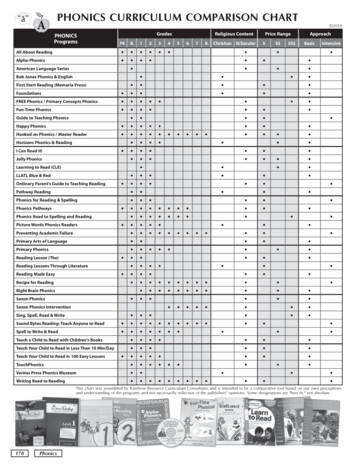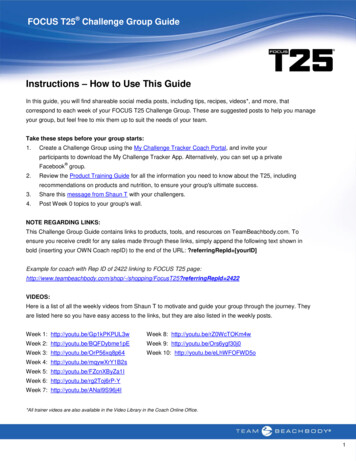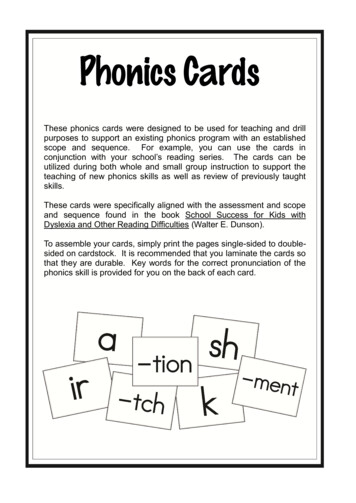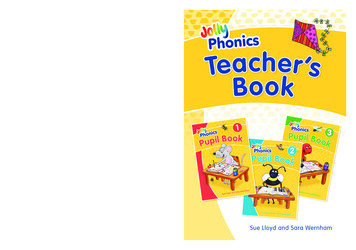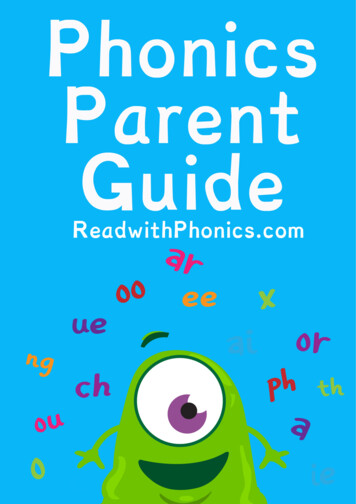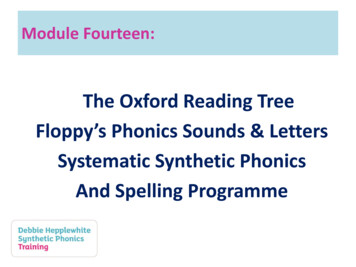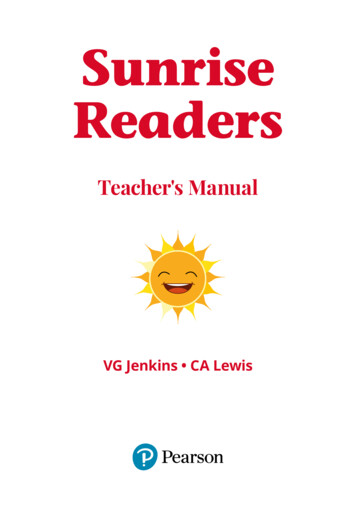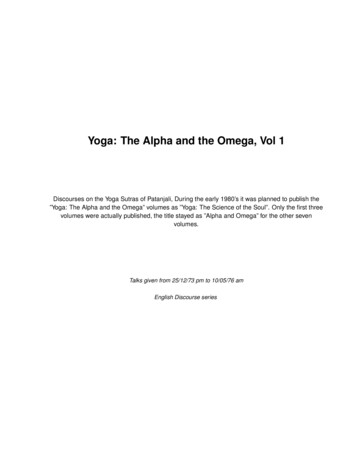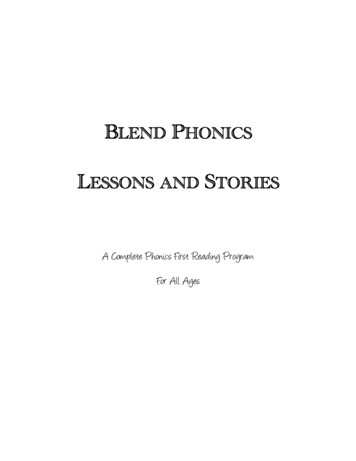
Transcription
For information:The Paradigm Co., Inc.P. O. Box 45161Boise, Idaho 83711(208) 322-4440FAX: (208) 322-7781Emai1: phonics@alphaphonics.comWebsites: www.alphaphonics.comwww.samblumenfeld.comCopyright c 1983 by Samuel L. Blumenfeld. All rights reserved. Nopart of this book may be reproduced in any form whatsoever withoutwritten permission from the publisher, except by a reviewer who mayquote brief passages in connection with a review.Manufactured in the United States of AmericaThirty-eighth Printing, August 2010Library of Congress Cataloging in Publication DataBlumenfeld, Samuel LAlpha-Phonics.1. Reading (Elementary) 1. Title.LB1573.B5S8 1983372.4’1 82 - 12873ISBN 0-8159-6916-3Books by Samuel L Blumenfeld:How To Start Your Own Private School And Why You Need OneThe New IlliteratesHow To TutorThe Retreat From MotherhoodIs Public Education Necessary?ALPHA-PHONICS: A Primer For Beginning Readersfor ordering information see last page
Click on the page number for quick accessAbout the AuthorBack Page
Back tocontentsPREFACEALPHA-PHONlCS was created to provide teachers, tutors and parents with asensible, logical, easy-to-use tool for teaching reading. It is an intensive phonicsinstruction program based on the author’s many years of research and experience in the reading instruction field. It answers the need for a practicalinstruction book that anyone who wants to teach reading can learn to usewith a minimum of training.This program can be used to teach reading to beginners of all ages, olderstudents in need of remediation and retraining, functional illiterates, dyslexics, special-needs students, the learning disabled, and non-English speakerswho wish to learn to read English and improve their pronunciation.It can also be used as a supplement to any other reading program being usedin the classroom. Its systematic approach to teaching basic phonetic skillsmakes it particularly valuable to programs that lack such instruction.The book’s step-by-step lessons in large, eye-pleasing calligraphy make itsuitable for both direct one-on-one tutoring and regular classroom use. Parents who wish to teach their children to read at home will find the bookparticularly useful, since it is written in normal, every day English and is freeof the professional jargon characteristic of so many reading instruction books.All of the lesson pages were carefully designed to eliminate distraction and tofocus the pupils full attention on the work at hand. The Teacher’s Manual, inthe back of the book. provides teachers and tutors with the necessary instructional information for each lesson. The program, as a whole, is flexibleenough so that any teacher or tutor can adapt it to his or her own teachingstyle or situation.If you have never taught reading before in this sensible, systematic way, youwill be pleasantly surprised by the results.Samuel L Blumenfeld
Back tocontents
Back tocontentsALPHA-PHONICS TEACHER’S MANUALINTRODUCTIONThis course of instruction will enable any teacher or tutor to teach reading to anyonewho needs to learn it: beginning readers of all ages or poor readers in need of retraining. The method is based on a thorough analysis of the English writing system, how itworks, and how best it can be taught.Written English is a purely alphabetic system, regardless of what we may think of itsmany eccentricities and irregularities. An alphabet, by definition, is a set of graphicsymbols that stand for the irreducible speech sounds of a particular language. Therefore, all of our written words stand for spoken sounds, no matter how irregular thespellings may be.We must not forget that the invention of the alphabet is based on one of man’s greatestdiscoveries: that all of spoken language is composed of a relatively small number ofdifferent speech sounds. (In English, only 44!)This is one of the great discoveries that has enabled man to do much more with muchless. Instead of wrestling with a writing system using thousands and thousands ofsymbols representing thousands of individual ideas and concepts, as in Chinese orEgyptian hieroglyphics, man could create a writing system using less than fifty symbols to handle an entire language.It is vitally important to understand the difference between an alphabetic writingsystem and an ideographic one. The latter uses graphic symbols to represent ideas,concepts, feelings, actions, things, etc. An ideographic system is basically independent of any particular language although many of its symbols may represent specificwords of a language. In an ideographic system language is used to interpret the symbols. Precision and accuracy are therefore hard to achieve with an ideographic system.An alphabetic system, on the other hand, is a sound-symbol system used merely torepresent on paper a particular spoken language. The spoken words stand for theideas, concepts, feelings, etc., while the written words are mere graphic representations of the spoken words. Therefore, in an alphabetic system, the relationship between written and spoken language is one of precision and exactness. The spokenword may be subject to interpretation, but the written word is an exact representationof a specific spoken counterpart. Thus alphabetic writing can also be a tool of thought,for the thought process uses the spoken language for its development.The invention of the alphabet, which took place about 2000 B.C., not only made hieroglyphics and every other ideographic system obsolete, it permitted a tremendous expansion of vocabulary because now there was a writing system that could easily accommodate it. The greatest works of the ancient world have come down to us throughalphabetic writing: the Iliad. the Odyssey. the Greek dramas, the Bible. Without thealphabet, man’s intellectual and spiritual development would have been seriously retarded. So we must regard the alphabet with great awe, respect, and even love. It Iscivilization’s prize possession.131
Back tocontentsIt stands to reason that a thorough knowledge and understanding of the English alphabetic system will enable a pupil not only to read well, but also to spell well. Weoften forget that our writing system is a two-way process: to be used both for readingand writing, decoding and encoding; and a pupil must become proficient in both inorder to be truly literate.Knowledge alone, however, does not lead to reading fluency. To gain fluency requiresall of the techniques used in developing a skill to the point where it seems effortless:practice, frequent use, drill, review, etc.This course of instruction makes full use of all of these proven techniques of learning.Moreover, it teaches in a logical, systematic way facts about our alphabetic systemwhich are usually taught rather haphazardly if at all. And it makes these facts operating knowledge for the student who wishes to learn to spell accurately and enlarge hisor her vocabulary.No one denies that the English alphabetic system is somewhat complex. But its complexity is hardly an excuse for not teaching it.For far too long, teachers of reading have avoided the difficulties of our alphabeticsystem by teaching sight vocabularies, whole-word configurations, context clues, andincidental phonetic clues. While such methods may produce some initial success onthe primary level, they are, in the long run, injurious because they violate the basicnature of our writing system and are not in harmony with its principles. They do notprovide the student with a fundamental understanding of the symbolic system we usein reading and writing, an understanding which he or she must have in order tobecome truly literate.It was Dr. Samuel T. Orton, the world’s foremost expert on dyslexia, who first warnededucators that the look-say, whole-word method could be harmful. He wrote in Educational Psychology in 1929 that the whole-word method “may not only prevent the acquisition of academic education by children of average capacity but may also give rise tofar-reaching damage to their emotional life.”ALPHA-PHONICS was created to make it unnecessary for any teacher to expose a childto teaching methods that can be harmful.OUR ALPHABETIC SYSTEMThe English alphabetic system may be complex, but it can be taught and it ought to betaught. We have an alphabetic system of great range and flexibility. Our spellingsreveal much about the history and development of our language, and once the eccentricities of the system are learned, they are learned. They do not change. Thereward for learning this system is to have for one’s personal use and enrichment theentire body of our published literature. Such a literary treasure is indeed the pricelessinheritance of everyone who can read.Our English alphabetic system is complex for a variety of reasons: (1) it uses 26 lettersto stand for 44 sounds; (2) it uses five vowel letters to stand for 21 vowel sounds; (3)many consonant letters stand for more than one sound; (4) some sounds, particularly132
the long vowel sounds, are represented by more than one spelling; (5) the invasions offoreign languages have enriched English but complicated its spellings (6) pronunciations have changed over the centuries but the spellings have not, creating manyirregularities.Despite all of this, our system is more than 80 percent consistent or regular, withmost of the irregularities consisting of variant vowel spellings.In devising this instruction program, we have taken all of the above into account.Therefore, we start out by teaching the pupil the short vowels, which are the mostregular in spelling, in conjunction with the consonants. Then we teach the consonantblends - final blends first, then the initial blends. Last, we teach the long vowels intheir great variety of spelling forms.Thus we proceed from the simple to the complex in easy stages, giving the pupil plentyof practice and drill along the way. The pupil learns to read and spell in an orderly,systematic, logical way, as well as to pronounce the language with greater accuracy.To some teachers this will seem like an overly academic way to teach reading. And itis, on purpose, because we want the pupil to learn to enjoy using his or her mind.In teaching someone to read English, we must decide what should come first: learningthe alphabetic system or enjoying inane stories with lots of irregular sight words. Thelatter may seem to be much more fun for teacher and pupil; but does it accomplishwhat we want to accomplish? If our goal is high literacy, it does not.We know from experience that the pupil will derive much deeper satisfaction by learning the alphabetic system first, because it will give him or her much greater overallreading mastery in a shorter period of time.Competency and skill are the two most important ingredients of self-confidence, andself-confidence is the cornerstone of self-esteem. Learning to read is the pupil’s firstreal exposure to formal education, and a positive attitude can be instilled in the youngmind by how we approach the subject at hand.It is obvious that one learns faster and better when the knowledge one is expected toacquire is organized in such a way as to make its acquisition as easy as possible. Thisis the concept behind ALPHA-PHONICS. Our aim is to provide the pupil with the kind ofbasic knowledge that will become the solid foundation of all his or her future academicwork.Of course, no instructional program teaches itself. Its success depends a great deal onthe teacher. This program has a good deal of flexibility and provides many ways tomeasure the pupils’ progress. But since pupils vary greatly in their prior knowledgeand capabilities, the teacher in some instances will have to tailor the instruction tothe individual pupil.While we have organized this course in a certain order to make sure that what shouldbe learned is learned, we have also done this to make the teaching of reading as easyfor the teacher as possible. We therefore advise the teacher to read this book in itsentirety before using it.133
Back tocontentsTEACHING THE ALPHABETThe fastest and most efficient way to teach the alphabet is to have the child repeat itafter you in alphabetical order while you point to the letters. Thus the child learns thealphabet both orally and visually at the same time. Usually the oral learning will befaster than the visual, since the oral alphabet when repeated often enough is learnedalmost like a melody or a poem. The alphabet lends itself easily to this kind of learningsince it can be broken up into rhythmical and rhyming lines as follows:ABEHLCFIDGJKMN0QRSTUVPWXYZIt will take some time, before the child’s visual learning catches up with his or her oralknowledge. Indeed, some children learn to recite the alphabet perfectly long beforethey are able to identify all of the letters at random. This is perfectly normal since thechild has had much oral practice learning to speak the language. However, now he isrequired to do highly precise visual learning which may take some getting used to,especially if the child has had little exposure to print.Children with photographic memories will learn visually much faster than those not sofavorably endowed. The slowest learners will be those with weak visual memories.These children will benefit most from simple alphabetic exercises, such as repeatingthe letters at random, several at a time, as in the Prereading Alphabet Exercises, (p.159).Both oral and visual learning of the alphabet should be accompanied by kinestheticlearning, that is, by having the pupil draw the letters in both capital and lower-caseforms. Drawing the letters will help the child learn their different shapes more thoroughly. A lined notebook should be used by the pupil for doing this work in class and ashomework.Another effective way for the child to learn to identify letters at random is to ask himor her to pick out specific letters from advertisement print matter in newspapers andmagazines. In this way the pupil learns to recognize the letters in different sizes andtype faces. This is also a good way to check on the child’s vision.134
Back tocontentsPictures are not necessary in teaching the alphabet if you do it in the systematicmanner prescribed in this program. The picture the child should be looking at is theletter itself, not an apple or a bumblebee, or an elephant.Pictures are a distraction that can only delay learning the alphabet directly as a set ofgraphic symbols. We make this point because shortly after the letters are learned, thepupil will be taught to identify them with speech sounds, and this is very crucial.A letter is a symbol of a sound. It is not the symbol of anything else.The letter is supposed to stimulate the mouth, lips, and tongue to make particularsounds. It is not supposed to make the pupil think of an apple or an elephant. He or shemust translate groups of letters into speech, and the pupil will be able to do this morereadily the better he or she associates the letters with sounds.A word of caution: When a pupil is having uncommon difficulty learning or masteringany phase of the instruction, do not become impatient and do not scold. Analyze andtry to pinpoint the cause of the difficulty. You may simply have to take more time thanyou thought necessary. Some students take a year to master what others can masterin a month. Remember, the goal is not to win a race but to teach a person to read - nomatter how much time it takes to do the job well.TEACHING THE LETTER SOUNDSAssuming that the pupilletter sounds. The pupil’sbefore we move on to thisthe letters better as theyhas learned the alphabet, we are now ready to teach theknowledge of the alphabet does not have to be letter perfectnext phase, for the simple reason that the student will learnare used.When you are ready to teach the letter sounds, you might explain to the studentsomething about how and why the alphabet was invented. Older students are usuallyquite fascinated to learn that the entire English language is made up of only 44irreducible speech sounds. Try, if possible, to appeal to the learner’s intellectual curiosity. You never know what kind of a response you will get.Pupils are very sensitive about their ability to learn. This is particularly true of remedial students whose self-esteem has been badly battered by failure. A learning blockor handicap, is not a reflection of basic intelligence. We all know of highly intelligentpeople who have trouble doing simple addition. We also know that many so-calleddyslexics are very bright and articulate. Therefore, always appeal to a pupil’s basicintelligence.When teaching younger pupils the letter sounds you might simply say: “Now we aregoing to learn the sounds the letters stand for so that you can put the letters to workfor you. Each letter stands for a different sound. You will be able to read words byknowing the sounds the letters stand for.”135
Back tocontentsThe essence of what you want to convey to the pupil is that letters have meaning - theystand for sounds - and that the letters in a written word tell the reader how to say it.In teaching the letter sounds, it is important to convey the idea that the distinctsounds of our language can be isolated and represented by written symbols. Obviouslythe alphabet was invented by someone who spoke clearly and heard clearly and coulddistinguish between the fine differences of speech sounds, between the t and the d,between s and z, m and n, short a and short e. But a pupil’s attunement to speechsounds may not be very sharp. In fact, some pupils may articulate very poorly andrequire a good deal of work to improve their pronunciations. Therefore, spend as muchtime as is needed to sharpen your pupil’s attunement to the isolated, irreduciblespeech sounds of our language as you teach the letter sounds. Be sure to pronounceall words clearly.The alphabet is a tremendously exciting invention based on a great discovery: that allof human language is composed of a small number of irreducible speech sounds. Inteaching the alphabet, you can convey to your pupil the excitement of this great discovery and the marvelous invention based on it “Did you know that every word you speakcan be put down on paper?” you tell the pupil. That’s exciting. “And that’s what you aregoing to learn to do - to put down on paper every sound of speech you make.”Thus you’ve established the concept of a set of written symbols representing speechsounds. This is the association you want to establish in the pupil’s mind: that letterson paper stand for sounds that he can make with his voice, and that the sounds hemakes can be put down on paper by way of letters representing them.SOME PRACTICAL SUGGESTIONSThis book has been designed to be used as both a tutoring and a classroom text. If theclassroom teacher has only one copy of ALPHA-PHONICS, then the pupils should beprovided with lined notebooks in which to copy lessons from the board. Ideally, eachpupil should have his own copy of ALPHA-PHONICS plus a notebook in order to facilitate the assignment of homework. This would also reduce the need for time-consuming board work by the teacher and costly duplicating.Tutored pupils should also, whenever possible, have their own copies of ALPHA-PHONICS for homework and reference use. The pupil should also have a lined notebook forpracticing cursive, spelling exercises, vocabulary lists, and sentence writing. It is advisable to assign some written homework after each tutoring session. The purpose ofhomework is to speed up the acquisition, retention, and improvement of skills. Theamount of homework should depend on the amount of time between sessions.Although the lesson instructions have been written from a classroom viewpoint, atutor will find them easily adaptable for one-on-one teaching. Simply substitute pupilfor class.136
Back tocontentsISOLATING THE LETTER SOUNDSIn articulating the letter sounds, the best way to isolate a consonant sound is to listento what it sounds like at the end of a word; then lift it from the rest of the word. Bydoing so, you will minimize injecting a vowel element.This can be done with consonants b, ck, d, f, g (as in tag and large), k, l, m, n, p, r, s,t, v (ve), x z (ze), sh, ch, th. Consonant c stands for the k sound before vowels a, o andu; it stands for the s sound before vowels e and i. The letter q is always followed by uand is pronounced as if it were kw.Some consonants - h, j, w, y, wh - do not appear as consonants at the ends of words.These can also be articulated in isolation with just the barest hint of a vowel element.By pronouncing the isolated sounds as purely as possible, the pupil will be able tounderstand what we mean by an irreducible speech sound.ORDER OF LESSONSLESSON 1: Have the pupils turn to Lesson 1 in their textbooks. Start by telling theclass (student) that you are now going to teach the sounds the letters stand for. “Whenyou learned the alphabet, you learned the names of the letters. Now you’re going tolearn the sounds the letters stand for. Let’s start with the first sounds. Now listen tothe sound I make.” Make a short a sound. (Short a is the a in cat) “Did you hear thatsound?” Make it again and ask the class to repeat it after you. “That sound is not aword all by itself, but you hear it and say it often in many words. Can you say it again?”After the class repeats the short a sound and hears you repeat it, print the letter a onthe blackboard. “The letter a that you see on the board and in your books stands for thesound you just made. It is called the short a sound. Now I am going to say five wordswith that sound in it, words that you use every day: am, an, as, at, ax” Print them onthe board as they appear in the book. Give examples of how each word is used in aspoken sentence, so that the class understands that they are words. A word is thesmallest unit of speech that has meaning. “The short a sound all by itself doesn’tmean anything. But a sound that means something is a word. Am, an, as, at, ax areall words because they have meaning.“Now each of these words has two letters in it. Can you name the letters?” Have theclass spell each word, saying the word after it is spelled. Spelling a word meansnaming its letters in proper left-to-right sequence. “Now if the words each have twoletters and each letter stands for a sound, how many sounds does each word have?”Repeat the word am slowly. Write and say the short a sound; then write and say theword am just below it “Do you hear the difference between a and am? When we sayam, we add another sound to the a. What is the sound we added to the a in the wordam?” Say the m sound as it is said in the word am. (To correctly isolate this consonant sound, listen to what it sounds like at the end of a word; then lift it from the restof the word. By doing so you will minimize injecting a vowel element.) After you’vemade the m sound, ask the class: “Did you all hear it? Can the class say it?” After theclass says the m sound, tell them that the letter m stands for the m sound. “So if wewant to write the word am we must write a-m, because these are the letters thatstand for those sounds.”137
Repeat the procedure for an, as, at, ax. In this instance teach the s as soft s. Just asthe vowel letters represent more than one sound, some consonants also have variantsounds. But at this stage, we are teaching only the sounds used in the words presented in the textbook Have the pupil print these words, say them, spell them. (Thismay also be a good time to start teaching cursive writing. For instruction on introducing cursive, page 156.) In any case, make sure that the pupils understand that eachword has two sounds and that they can match the right sound with the right letter.Point out how the name of each letter, except a in this instance, gives them a hint ofthe sound each letter stands for. Exaggerate the sounds so that the class can hearthem distinctly and learn to recognize them when heard.When you are convinced that the class knows these letter sounds thoroughly, tellthem that there are two kinds of letters in the alphabet - vowels and consonants. A isa vowel and m, n, s, t and x are consonants. The other vowels are e, i, o, and u. All therest are consonants, although y is sometimes used as a vowel. Explain that the vowelsare the most powerful letters in the alphabet, because you can’t have a word withoutone. Consonants need vowels in order to make words. They can never stand alone.You needn’t elaborate at this point, suffice it merely to establish the fact that thereare two classes of letters: vowels and consonants.By now the class has learned a great deal. They are beginning to hear words with agreater awareness of their different sounds, and they have seen how these differentsounds are represented in their books by alphabet letters. They see that the lettersare printed from left to right in the same sequence as they are spoken. The five wordscan also be printed on cards and flashed to the class in short drills to help developquick recognition.LESSON 2: Review all of the material taught in Lesson 1. When that is done, print theword am on the board. Tell the class that you are going to make a new word by addingS to the beginning of it. Ask if anyone can figure out what that new word is. The wordis the name Sam. Ask them how many sounds are in that word. Have them identifythe three sounds in the order they are printed. Explain that we use a capital S in theword Sam because it is a proper name and all proper names begin with capital letters.Repeat this procedure with the other words in the lesson. With the word has identifythe sound the letter h stands for.LESSON 3: Have the class study all of the words in the lesson and read them aloud.Now tell them that they know enough words to be able to write their first sentences:Sam sat. Sam has an ax. Explain that a sentence begins with a capital letter, whetherthe first word is a name or not, and that it ends with a period. Define a sentence as acomplete thought.LESSON 4: Teach the sound the letter d stands for to make the word ad. Expand ad todad. Introduce the sound of the letter w. Put the w in front of ax and see if the classcan figure out the word wax. Place D before an to make Dan. Have the class read thetwo new sentences.LESSON 5: By now the class should begin to understand the principle behind alphabetic word building, how each letter’s sound is used in writing words Have the classread the words in their columns. By using all of the letters known by the class, theirreading vocabulary has been expanded to 25 words. Point out that the word was, whilein the as, has spelling family, is pronounced wuz. This is an irregular pronunciation.Thus the class has been made aware that there are irregularities in the system.138
Back tocontentsORDER OF LESSONSLESSON1. Short a; consonants m, n, s, t, x2. Initial consonants S, m, h, s, t3. Review sentences4. Consonants d, D, w5. Alphabetic word building6. Short a sentences; punctuation7. Consonant blend nd; consonant I8. Consonants l, b, c, g, j, f9. Consonants p, t, r, v, y, z10. Review of short a words11. Consonant digraph ck; qu12. a as a word13. Sentences14. Review of short a words and syllables15. Short vowels a, e, i, o, u16. Short e words17. Short e sentences18. Short e words and syllables19. Short j words; ph as f20. Short a, e, i sentences21. Consonant digraph th22. Sentences23. Short o words24. Short o sentences25. Plural s, es, and ‘s26. Sentences27. Short u words28. Short u sentences28a. Consonants b and d29. Consonant digraph sh30. Consonant digraph ch31. Consonant digraph wh32. Review of sh, ch, wh words33. Sentences34. Verbs to be and to have35. Sentences36. Contractions37. Sentences with contractions38. Two-syllable, short-vowel words39. Sentences with two-syllable, short-vowel words40. a as in all; sentences41. Consonant blend ng; ing words42. Sentences with ing words151
43. Final consonant blends nd, nt44. Sentences45. Final syllable er, er words and sentences46. Final consonant blends nk, nc, nch, 6347. Sentences48. Final consonant blends ct, ft, pt, xt; sentences49. Final consonant blends sk, sp, st; sentences50. Final consonant blends ib, id, if, lk51. Final consonant blends im, lp, it52. Final consonant blend mp53. Final consonant blend tch; sentences54. Final consonant blend dge55. Final consonant blends nce, nse56. Review of words with final consonant blends57. Two-syllable words with consonant blends58. Initial consonant blends bl, br59. Initial consonant blends cl, cr60. Initial consonant blends dr, dw61. Initial consonant blends fl, fr, 7362. Initial consonant blends gl, gr, gw63. Initial consonant blends bl, pr64. Initial consonant blend sl65. Initial consonant blends shr, sm, sn66. Initial consonant blends sp, spr67. Initial consonant blends st, str68. Initial consonant blends sw, sc, sk, scr69. Initial consonant blends tr, thr, tw70. Words with consonant blends71. Sentences72. Long a73. Long a as a-e74. Sentences with long a words75. Long a as ai76. Long a sentences77. Long a as ay and ey78. Long a sentences79. Long a as ei and eigh; sentences80. Review of words with long a spellings81. Long a homonyms82. Two-syllable words with long a syllables83. Vowel spellings au, aw84. Sentences with au, aw words85. a as in ma, car86. Sentences with a-as-ah words87. Long e as ee152
88. Long e sentences89. Long e as ea90. Long e sentences91. Long e as e-e; sentences92. Long e as ie; sentences93. Long e as y94. Long e as y sentences95. Plural ies96. Review of long e words97. Long e sentences98. Long i as i-e, y, ie99. Long i sentences100. Long i as igh; sentences101. Spelling forms ough and augh102. gh as f103. Long o as o-e104. Long o sentences105. Long o as oa; sentences106. Long o as ow; sentences107. Long o as in old; sentences108. Common irregular words109. oo as in good food110. Sentences with oo words111. Spelling form ould; sentences112. ow and ou as in cow and ouch113. Sentences114. oy as in
Alpha-Phonics. 1. Reading (Elementary) 1. Title. LB1573.B5S8 1983 372.4’1 82 - 12873 ISBN 0-8159-6916-3 Books by Samuel L Blumenfeld: How To Start Your Own Private School - And Why You Need One The New Illiterates How To Tutor The Retreat From Motherhood Is Public Education Necessary? ALPHA
